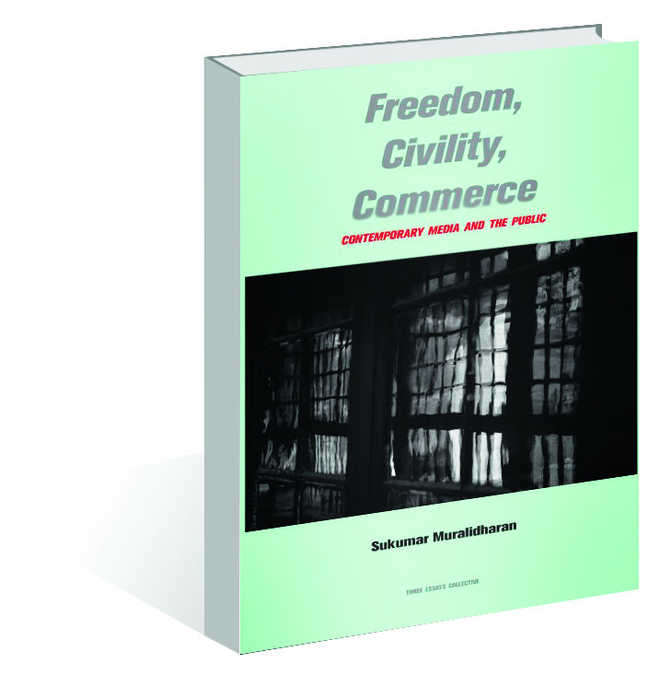
Freedom, Civility, Commerce: Contemporary Media and the Public by Sukumar Muralidharan. Three Essays Collective. Pages 490. Rs 950
Sandeep Dikshit
Journalists have rarely meddled with the rarified echelons of scholarship from the perusal of archival material. Even fewer have sought to fuse them with current events. Theirs have generally been accounts that are up-close to events and their makers. Sukumar Muralidharan melds both genres to weave a closely knitted book with the media as its axle, as he chronicles the gradual moral entrapment of Indian civic and political life in the bright arcs of foreign money, a sense of status quoism and the call of the market.
The book diffuses itself into eight chapters or issues, all tempered with a thought process that shuns the mindless mainstream course, preferring to begin from the beginning to make the case. The initial entanglement with philosophers, sociologists and thinkers can at first glance induces somnolescence, but perseverance is rewarding.
Take the chapter on Satire, where Sukumar takes up the shootout at the French magazine Charlie Hebdo. The mainstream narrative is pristine: this was an assault against the principles of free speech. No questioning that. The follow-on script was moving and a spectacle: world leaders linked hands in the centre of Paris (never mind that a certain Benjamin Netanyahu was among them) while the French President and the land’s movers gathered at the Cathedral of Notre Dame (steeped in Catholicism) in memorial of the victims.
Charlie Hebdo’s editorial principles are dissected to reveal the brittleness of its standards and that of the French state. Satire overstepped a red line when it was unwilling to grant latitude to symbols of Islam in public space, in fact joining in the scapegoating of the migrant community. The threads extend to the French colonisation with Albert Camus convincingly panned for reaffirmation. India, too, has had it brushes such as Shankar’s cartoon showing Nehru whipping Ambedkar and it has continued apace since with the frequency of social conflicts putting strains on media objectivity.
In India, it was not Indira Gandhi or Narendra Modi who garrotted speech. A patchy freedom had produced a state that was bound to resile on the promise of freedom of speech. Within four years of Independence, publications of both the left and the right faced crackdowns. The Supreme Court restored their rights but the insecurities of the Indian nation-building project meant that after that it went up only to a point. Restrictive laws began emerging in the Nehru era and were tightened with each specific terrorist outrage, with September 11, 2001 becoming the salvation of this securitarian fantasy. Luckily, there were times when the political audience was receptive to demands for their repeal, but as Sukumar chronicles, the tales of the hapless caught between the interstices of the state and militancy or the judiciary and the powerful. The rule of the thumb is usurpation of individual autonomy.
The media is now in several avtars. Sukumar examines all of them. In tune with the seamlessness of their spread, from civil society to the market and even the practice of journalism, the discussion does not remain within national boundaries. The civil society movements, with the media inseparably tied, were a post-Cold War phenomena. And they differed in their reach and goals. But Sukumar establishes that in contrast to the serenading of Facebook and Twitter for facilitating those protests, the media is just an enabling factor. It was the newness of these tools that introduced this perception. Otherwise, the movements of 1848 should be ascribed to the invention of the telegraph and the railroad, which had appeared around the same time.
There was a crucial difference between the Arab Spring and the Anna Hazare movements: the Indian mainstream media devoted itself exclusively to both his fasts chosen for their prominence. The upheavals in the advertising world that finally ushered the Modi phenomena, the battles between newspaper magnates, the quiet exertions of the conscientious are all chronicled with a wry touch. Commenting on Shekhar Gupta’s memo to colleagues after the 2008 crash that upended the India media for good, Sukumar says: it was a call to severe austerities of the flesh and soul by one who was renowned for being among the most avid celebrants of the cult of material success.
The book takes its time. But the treatment of the issue, right from its inception and an examination unfettered by geography, time and the medium of the media, reveals a world that is slightly varied from the way we are asked to look at it.


























